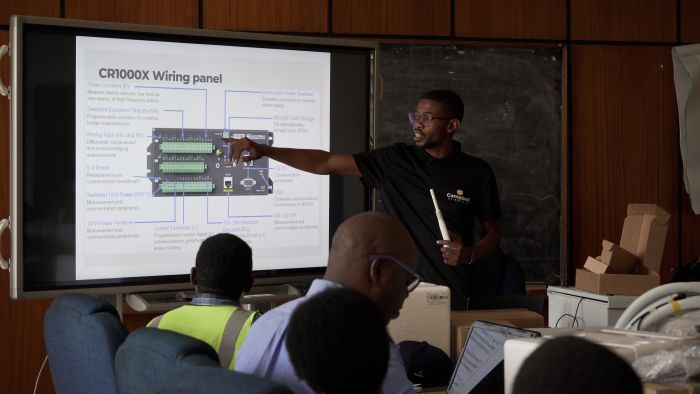









Overview
In May 2019, the Government of Zambia embarked on the Central Asia Water & Energy Program (CAWEP) World Bank-funded project. One crucial facet of this project aims to bolster the nation's capability to harness climate and hydrometeorological data to build climate change resilience. Zambia's geographical and climatic diversity necessitates a comprehensive and reliable meteorological network to enhance weather forecasting and climate resilience for its populace.
The Challenge
Prior to the inception of CAWEP, Zambia's meteorological network consisted of a blend of manual and automatic weather stations, with uneven coverage across the nation. Given the country's vulnerability to climate fluctuations, this limited network hindered weather prediction accuracy, adversely affecting various sectors from agriculture to infrastructure development.
The Solution
To address these challenges, Campbell Scientific was entrusted with the task of supplying and installing 120 automatic weather stations (AWS) across Zambia. The scope of this undertaking was extensive and demanding, necessitating meticulous planning and execution. Our weather stations, renowned for their reliability, durability, and operational simplicity, were ideally suited for this role. Our CR1000X Measurement and Control Datalogger, equipped with MQTT capabilities, facilitates seamless data transmission to World Meteorological Organization (WMO) Information System 2.0 (WIS 2.0), aligning these weather stations with WMO requirements. This capability contributes significantly to the global efforts of closing data gaps in the Global Basic Observing Networks (GBON).
The GBON addresses significant gaps in global surface-based data, impacting the quality of weather and climate services worldwide. The implementation of GBON standards, as agreed upon by 193 members of the WMO in 2021, marks a transformative step in international data exchange.
Learn more about GBON and compliant observation solutions.
In addition to the installation of a weather station network, the scope of work entailed comprehensive training for technicians and weather-data users to ensure long-term project sustainability.
To assure a seamless project implementation, we collaborated with local contractors, thus creating local empowerment through knowledge transfer and employment creation. The scope of work included civil works (foundations and fence installations). The project was challenging, as the team had to contend with the rugged terrain and difficult road conditions that often result in vehicular breakdowns. Our commitment to the project extended even to river crossings, where small row boats were essential for transporting equipment. Furthermore, two of our staff members completed advanced 4x4 driving courses to navigate the demanding landscapes and access weather stations in remote areas.
Training
As part of the CAWEP project, we conducted a comprehensive three-day training program for the Zambia Meteorological Department (ZMD) and their partners. This training covered AWS installation, operation, and maintenance, as well as proficiency in using the network management tool with its archival and backup systems.
Equipping our clients with in-depth knowledge of our data loggers and software ensures that they can confidently manage their own equipment. Understanding each sensor's functionality and being adept at error detection fosters a proactive approach to maintenance. By empowering our clients with this expertise, we contribute not only to the success of individual projects but also to the broader goal of creating a self-reliant and proficient group of weather monitoring professionals. We believe that by sharing knowledge, we build resilience, ensuring the longevity and effectiveness of weather monitoring systems worldwide.
The Benefits
The impact of this project is manifold and poised to be far-reaching:
- Enhanced Livelihoods: A denser meteorological network equips Zambia with critical weather and climate information, thereby supporting improved livelihoods across various economic sectors. Accurate weather forecasts aid farmers in making informed decisions, leading to increased agricultural productivity.
- Climate-Proof Infrastructure: The expanded network provides the foundational information required to climate-proof major infrastructure projects, safeguarding investments and ensuring long-term sustainability.
- Global Weather Monitoring: Zambia's increased contribution to global weather monitoring and forecasting enhances the world’s understanding of climate patterns and fosters international collaboration in addressing climate change.
As part of our commitment, we also provide ongoing training and technical support to the ZMD staff to install, operate, and maintain the AWS network. Our comprehensive training schedule encompasses every facet of the system, ensuring that ZMD is well-equipped to manage this vital network.
In conclusion, Campbell Scientific is honored to play a role in Zambia's CAWEP project, enabling the nation to harness the power of climate data for development and resilience. We remain dedicated to providing ongoing technical support and training, ensuring the sustainable success of this transformative initiative. By working together, Zambia is now empowered to thrive in the face of climate challenges, one weather station at a time.
Zusammenfassung Projekt
Anwendung
Harnessing climate and hydrometeorological data to build climate change resilienceStandort
Zambia (multiple locations)Verwendete Produkte
LWS HMP155A-L CELL215 CR1000X SOILVUE10Beteiligte Organisationen
Campbell Scientific Africa regional officeGemessene Parameter
Air temperature, relative humidity, wind speed and direction, solar radiation, soil moisture, evaporationpdf anzeigen